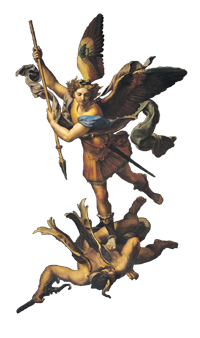Building Up from Stuff

The two preceding essays traced the concept of consciousness down from its highest form of abstraction, in God, to human beings. This essay turns things around and builds up to the same point from the bottom — from the stuff of the Universe.
In the beginning is the radical proposition that there is no stuff. No matter how minutely we manage to drill into matter, we will not come to a material substance out of which everything is built. The notion of particles is simply an imprecise metaphor we’ve used to help us understand the concepts.
As at the top, so at the bottom: There are only ideas. At the top, the full set of concepts equates to a personality, which is God’s, who disaggregates through relationships. At the bottom, at their most disaggregated, the concepts manifest as qualities and rules.
Articulated individually and in combination, the qualities generate points in space-time, giving each point and then combination of points identity as a thing, or a concept on a higher level. The rules create what we perceive as distance and motion by requiring, for instance, that spins, charges, and “muchness” (i.e., mass) repel or attract each other. Where some points are unable to pass through others, it is not because there exists an impenetrable wall of stuff. The metaphor, at this level, would be more like the invisible fence to keep a dog in the yard, or the force that absolutely prevents a person who is afraid of heights from nearing a high edge or a person who is terrified of public speaking from stepping out on stage, but rather than representing a phobia, the force is simply an essential rule. This identity, with its particular collection of qualities, simply cannot approach those identities, closely enough to slip by them, while their qualities draw them together.
We’ll explore how pure ideas cohere into substance when we return to the topic of reality as a relationship between observers. For the moment, the key point is that Creation consists of identities that cohere as distinct things based on the qualities that they possess. The quark is an identity. Protons, neutrons, and electrons are identities. One level up, when they combine into atoms, those are identities. And so on. They are distinct things only inasmuch as they are identified as such at a particular level of analysis or conception. Zoom far enough in on a digital picture, and you’ll see a field of dots, differentiated only by the quality of color that you perceive. Just so is the Universe-wide field of points in space-time. One must zoom out to a higher level of observation to see the patterns and discern the rules by which they take shape, and those patterns make up things — identities — on the level at which they can be observed.
It is helpful to personify identities at least to the extent of imputing to them knowledge. However, without implying consciousness, we’ll define knowledge as the recording within an identity (however fleetingly) of information through some sort of internal change. If you add a marble to a jar, the jar “knows” there has been a change; that is, it has recorded it. If the jar only has the one marble and you spin it, then the jar “knows” something is happening to make the marble move around within it.
At the most fundamental level, particles do not know that they are moving, spinning, vibrating, or whatever, because they have no means of recording that information with a change inside themselves. They are only in motion relative to other identities from a higher level of observation. Think how human beings did not know they were moving through space at great speed because that fact causes no change inside of us by which to record the information. We only figured it out through distant observations, which ultimately caused a change inside our brains to record the information.
Fundamental identities simply are as they are, and they exist underneath the rules by which they abide. From an external perspective, they may be moving toward each other, but inasmuch as nothing changes within them, the motion has no meaning for them. By definition, space-time will adjust such that opposite charges move toward each other, but that information is recorded in space-time. The charges, as identities, don’t change internally in response; they simply exist by means of the effect they have on the next-higher conceptual level.
(Note that we may find something within fundamental particles that records the changes. My argument, however, is that eventually we will reach a point at which the level of analysis cannot go any lower and the identities simply follow the rules.)
Now, just as we stepped down by level from the core idea of God to human beings, we can begin to step up from the ideas at the bottom of creation. From atoms on up to rocks, identities record information by changes imposed on them. A piece is knocked off. A crack expands. Atoms wear away from passing wind. The inanimate object only knows what is happening outside of it when there is a direct interaction that changes the object in some way.
What we categorize as life begins when an identity responds to the environment internally. At the basic level, this is still an entirely mechanical or chemical process of direct interaction, but the change occurs within the organism. The plant does not observe that sunlight exists at some elevation and grow toward it. The plan only knows that the chemical reactions that sunlight causes are not happening, and that fact produces a different internal reaction.
The most basic animals are not much more advanced. Ants, for instance, are responding to chemical changes when they follow a trail, but their processing is less direct. The detection of pheromones by antennae doesn’t mechanically change the direction in which the ant’s body moves, but the decision-making is basic.
Moving up the scale, as senses improve, they introduce a layer of awareness of the wider world, and the mechanism for processing and responding to stimuli, the nervous system, becomes able to address indirect information. The light carries information that a threat or food source is out there, and the animal responds accordingly.
The capacity for identities to respond to indirect information generates a higher conceptual level from which they can observe changes and understand new rules for how reality works. Importantly, this higher level allows animals to begin existing across time, in the future or the past, inasmuch as they can predict what might happen and respond as if it is, indeed, happening. A deer running from a wolf is not reacting to being bitten or even, necessarily, chased, but to a possible future in which that occurs. The deer exists in a range of probabilities over a certain distance of time and reacts accordingly.
Human beings achieve the next-higher level of conceptualization through our ability to think in abstractions. Spreading our existence to an abstract realm of forms, we can understand by logic another layer of rules (metarules, if you will), which we perceive not only intellectually, but also emotionally, through the chemical mechanisms of our feelings. These two species of information give the realm of forms observable influence on the world around us, by means of our responses, as well as those of other people.
In our sensing of something higher, we’ve reached the level of angels. We can’t fully know what reality looks like for them — at the level of words, as I put it while disaggregating the top-down teleology — because we lack the sensory apparatus to observe it and the cognitive apparatus to store the information. We can begin to sense the rules of the relationships that would be visible from that higher level; we can aggregate ourselves into groups, form longstanding institutions, and join in with intellectual and emotional movements that take on a life of their own; but we can’t know what it’s like to exist at the level that hovers fully above material Creation.
Obviously, each of the points made thus far in this series of essays demands more-detailed exploration, and the paths that lead away from them into specific disciplines and practical conclusions are as limitless as life itself. However, in the present sketch, the purposeful, or teleological, hierarchy of reality has now met the consequential, or nomological, hierarchy. The next step will be to decide whether they merely crash into each other or overlap from top to bottom and explore the implications our decision has for Creation and for us.
Featured image on Shutterstock.


